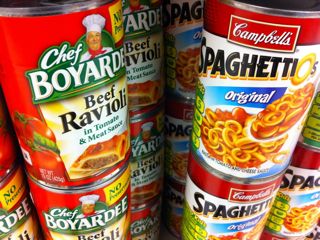I am a Chef man.
In a household that had a strict home-cooked dinner routine which included school reports and entrees that stretched a kid's palate, there was always, tucked comfortingly away on a pantry shelf, my beloved Chef Boyardee beef ravioli in tomato sauce. Serving as an after-school snack it fueled adolescent growth as much as Mom's meatloaf in mustard cream sauce and quite a bit more than the parsnips I smeared around my plate.
Easy for a kid to prepare, accepting of early recipe experiments (hot sauce, cheddar, cream cheese), firm enough for a fork but possessed of the soft saturation that noodles acquire when sauce and pasta have become one. The al dente of adults can't be slopped onto a toasted Thomas English muffin like this.
 Somewhere along the way, like discovering a friend was a fan of disco, we all found out some of our circle were Franco-American devotees. Their taste for ketchup-flavored Spaghetti-Os beyond understanding. Too-small "O"s that slithered between the tines of a fork back into a sweet orange sauce? Really? And these kids were as stuck in their abominable after school choice as you were in your correct one. THOSE households dropped off the after-school visit list.
Somewhere along the way, like discovering a friend was a fan of disco, we all found out some of our circle were Franco-American devotees. Their taste for ketchup-flavored Spaghetti-Os beyond understanding. Too-small "O"s that slithered between the tines of a fork back into a sweet orange sauce? Really? And these kids were as stuck in their abominable after school choice as you were in your correct one. THOSE households dropped off the after-school visit list.
A comfort food was born when a Cleveland restaurant run by a Chef Boiardi could no longer keep up demand for its homey menu. He opened his first factory in 1928 and branded the line Chef Boyardee to help Americans pronounce his name correctly. Hunger for the canned pastas, including from the US military, continued to outstrip his ability to expand and he sold the line, by then including cannelloni, macaroni and meatball spaghetti, in 1946 -- having truly become an American, and correctly pronounced, household name.
Franco-American was and is a division of Campbell's, admittedly also a home-grown institution, but one already a corporate force by the time its attention turned to an expansion into kiddie foods in the 1960s. A new product was developed specifically to appeal to bland-palated children, even spawning experiments with formed noodles in the shape of soldiers and cars before rolling out with the "O"s. Yeah.
The image on a can of Chef Boyardee is Chef Boiardi himself. Spaghetti-Os sported a dopey noodle face through most of its history rather than the mug of its marketer Donald Goerke. At their inceptions the products were home cooking vs marketing savvy. Simple Italian food vs Mad Men.
Both brands grew exponentially after their births last century, rising to become staples on American tables. Both now have a jillion dollars in sales and are part of corporate giants, but volume similarities are not the point. Nearly every kid ate one or the other regularly, never both. The choice was polarizing. In fact the canned food aisle became host to one of our earliest childhood lessons in taking a stand, and to this day the same macaroni moment still plays out in front of exasperated parents across the nation.
So fess up. Was it "Mommy, can we get Chef Boyardee?" Or was your tantrum for Spaghetti-Os? For an American immigrant success story or a case study in targeted marketing? The product of a Mr. Boiardi or a Don Draper?
Because you know as well as I do, in the quickening of kid's canned noodles, there can be only one.